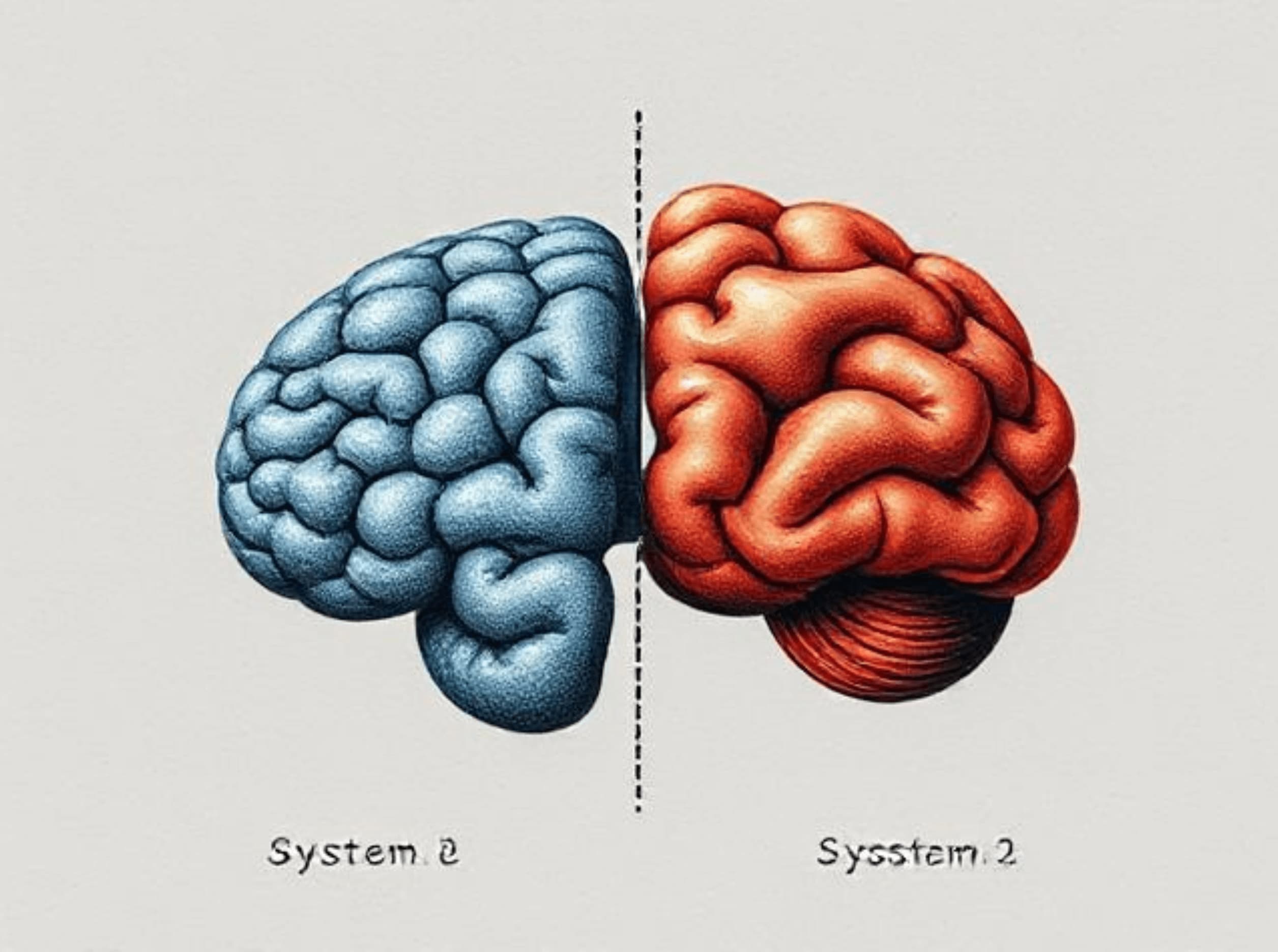
Daniel Kahneman’s dual-process theory revolutionized our understanding of human cognition by splitting our minds into two systems: System 1, rapid and intuitive, and System 2, slow and deliberate. But could this theory also illuminate something fundamental about how Large Language Models (LLMs) process information?
AI’s Cognitive Duality: Fast and Slow Thinking
Traditionally, LLMs operate in a way reminiscent of Kahneman’s System 1—fast, associative, and intuitive. They swiftly recall patterns from their vast memory of training data. This works impressively well for many tasks, such as casual conversations, straightforward translations, or basic information retrieval. But, as with human intuition, this quick response can stumble badly on tasks requiring careful reasoning, logical deduction, or multi-step problem-solving (Kahneman, 2011).
Humans trigger System 2 thinking when they encounter complex tasks or detect uncertainty. This system involves deliberate, analytical thinking, often involving multiple reasoning steps or explicit calculations.
The Power of Chain-of-Thought Prompting
Enter Chain-of-Thought (CoT) prompting—a simple yet groundbreaking technique that dramatically alters LLM behavior by guiding them to explicitly reason through tasks step by step. Recent research has empirically shown how transformative this can be. For instance, simply prompting a model with the phrase “Let’s think step by step” can skyrocket performance from a mere 17.7% accuracy to nearly 80% on complex math tasks, without additional training or fine-tuning (Wei et al., 2022).
Similar findings were documented by Kojima et al. (2022), who demonstrated that a large-scale model, PaLM (540B parameters), improved from an accuracy of 18% to 58% on the challenging GSM8K math benchmark simply by employing CoT prompting. Moreover, introducing self-consistency—generating multiple reasoning paths and selecting the most frequent final answer—further boosted accuracy to approximately 75% (Wei et al., 2022).
These remarkable improvements suggest that LLMs have a latent capacity for deliberative reasoning similar to System 2, which is embedded within their vast neural architectures. Without explicit prompting, models default to quick but superficial associations. When prompted to articulate their reasoning steps, however, they systematically approach problems, mirroring the slow, deliberate reasoning that humans employ when confronting complex tasks.
Autonomous Reasoning: The Next Frontier?
But here’s where things get truly fascinating: unlike humans, LLMs currently rely entirely on external prompts to shift into deliberative reasoning. Humans intuitively know when to slow down and apply careful thought—an ability that LLMs have yet to develop autonomously.
DeepSeek has been explicitly trained to consistently elicit chain-of-thought reasoning. While significantly enhancing its reasoning capabilities, this constant deliberation approach notably increases response lengths and, consequently, training and inference costs (DeepSeek AI, 2024).
Currently, LLMs lack genuine awareness of their own uncertainty, often confidently generating inaccurate responses, a phenomenon known as hallucination, which comes from the nature of how these models work. What if, much like humans, LLMs could recognize when they lack sufficient knowledge or certainty, triggering a deliberate, analytical mode of reasoning (System 2) only in those critical moments. Such self-awareness and adaptive reasoning could profoundly enhance the reliability and effectiveness of artificial intelligence systems. How would that look?
Rethinking Human Inspiration in AI Development
But why replicate human thought patterns at all? Don’t we develop machines to be better than us? Historically, technology has excelled by moving beyond human constraints, surpassing human speed, precision, and parallel processing. Yet, the unintentional alignment of AI with cognitive frameworks like Kahneman’s dual-process theory presents an intriguing paradox—our quest for superior intelligence circled back to human cognition.
Leaning too heavily on human cognitive theories, with all their inherent biological and evolutionary limitations, might unintentionally cap AI’s potential. While human cognition is adaptive and powerful, it is also fundamentally constrained. Large Language Models, free from these biological limits, possess an entirely different scope of cognitive possibility. Recognizing and deliberately transcending these human-inspired boundaries could unlock unprecedented capabilities.
Conclusion
Kahneman’s dual-process theory undoubtedly provides valuable insights into AI’s current cognitive behaviors, effectively guiding breakthroughs like Chain-of-Thought prompting. However, we must remain cautious about strictly adhering to human cognitive paradigms, as doing so could inadvertently constrain AI’s extraordinary potential.
Ultimately, embracing both the strengths and the inherent limitations of human cognition can help us forge a more nuanced approach—one that leverages human-inspired strategies where beneficial, yet boldly explores uniquely artificial avenues. By striking this balance, we can push AI systems beyond traditional boundaries, enriching not just technology but our collective understanding of intelligence itself.
References
- Kahneman, D. (2011) . Thinking, Fast and Slow. Farrar, Straus and Giroux.
- Wei et al. (2022). Chain-of-Thought Prompting Elicits Reasoning in Large Language Models. arXiv preprint arXiv:2201.11903.
- Kojima et al. (2022). Large Language Models are Zero-Shot Reasoners. arXiv preprint arXiv:2205.11916.
- OpenAI. (2023). GPT-4 Technical Report.
- DeepSeek AI. (2024). DeepSeek: Scaling Open-Source Language Models.